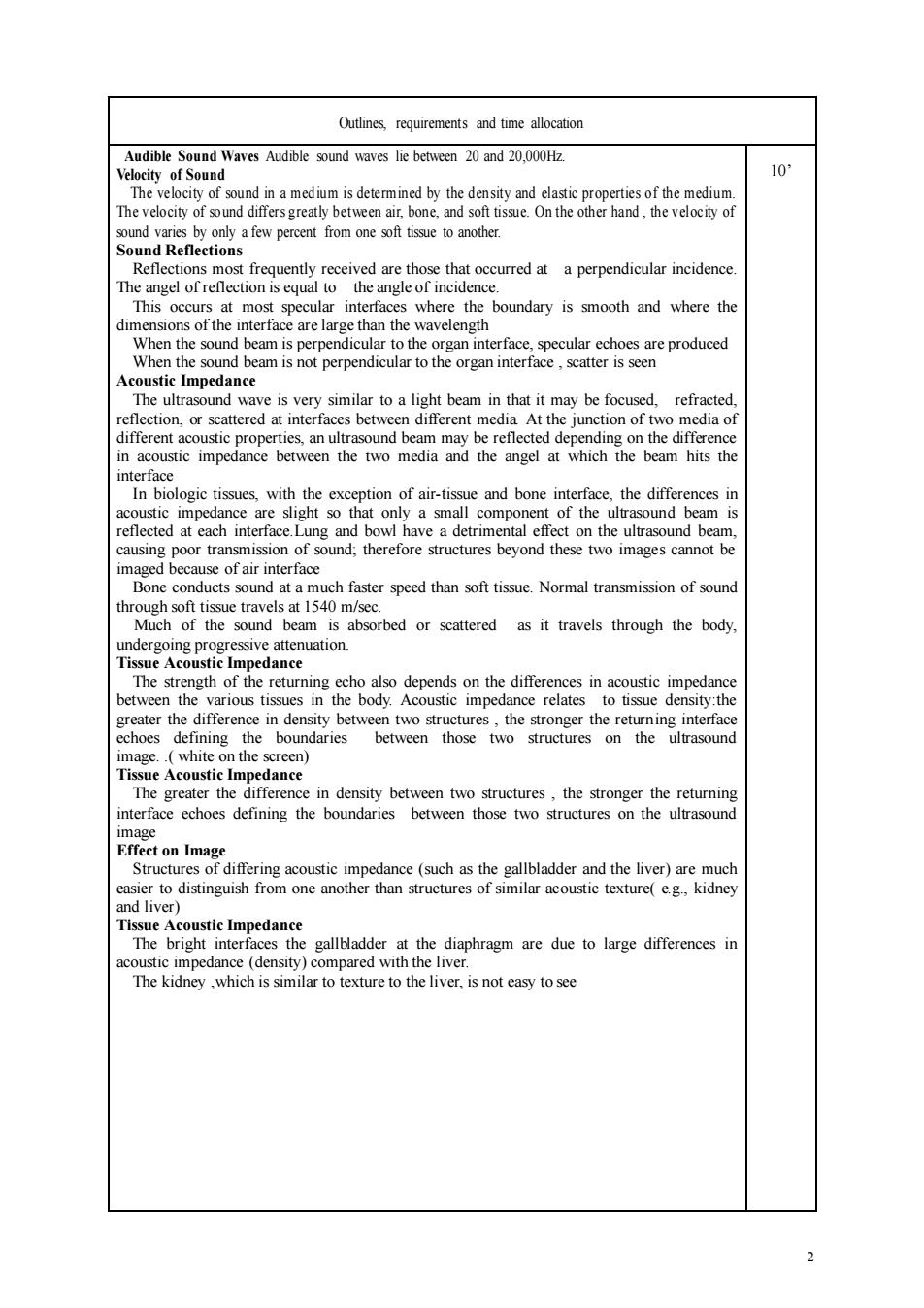正在加载图片...

Outlines requirements and time allocation Wavese soud ie beccn20 to. ound varies by ony a few percent from one is to another. Reflections most frequently received are those that occurred at a perpendicular incidence dime Acoustic Impedance The ultrasound wave is very similar toa light beam in that it may be focused,refracted uic pane betwen the tomedad te'gcwhich hbm hits he in thec nt ion of air-tissue and bone inte no in ound beam is ace. beyond o images cannot scattered as it travels through the body. f the between the various t greater the differer w山光 ture e in density between two structures the str nterface choes defining the boundaries between those two structu son the ultrasound Etectonlmagdgosceghsheeahap网rgca as sier to distinguish from one another than structures of similar acoustic texture(eg kidney and The bright interf es the gallbladder at the diaphragm are due to large differences in liver,is not easy tosee 2 2 Outlines, requirements and time allocation Audible Sound Waves Audible sound waves lie between 20 and 20,000Hz. Velocity of Sound The velocity of sound in a medium is determined by the density and elastic properties of the medium. The velocity of sound differs greatly between air, bone, and soft tissue. On the other hand , the velocity of sound varies by only a few percent from one soft tissue to another. Sound Reflections Reflections most frequently received are those that occurred at a perpendicular incidence. The angel of reflection is equal to the angle of incidence. This occurs at most specular interfaces where the boundary is smooth and where the dimensions of the interface are large than the wavelength When the sound beam is perpendicular to the organ interface, specular echoes are produced When the sound beam is not perpendicular to the organ interface , scatter is seen Acoustic Impedance The ultrasound wave is very similar to a light beam in that it may be focused, refracted, reflection, or scattered at interfaces between different media. At the junction of two media of different acoustic properties, an ultrasound beam may be reflected depending on the difference in acoustic impedance between the two media and the angel at which the beam hits the interface In biologic tissues, with the exception of air-tissue and bone interface, the differences in acoustic impedance are slight so that only a small component of the ultrasound beam is reflected at each interface.Lung and bowl have a detrimental effect on the ultrasound beam, causing poor transmission of sound; therefore structures beyond these two images cannot be imaged because of air interface Bone conducts sound at a much faster speed than soft tissue. Normal transmission of sound through soft tissue travels at 1540 m/sec. Much of the sound beam is absorbed or scattered as it travels through the body, undergoing progressive attenuation. Tissue Acoustic Impedance The strength of the returning echo also depends on the differences in acoustic impedance between the various tissues in the body. Acoustic impedance relates to tissue density:the greater the difference in density between two structures , the stronger the returning interface echoes defining the boundaries between those two structures on the ultrasound image. .( white on the screen) Tissue Acoustic Impedance The greater the difference in density between two structures , the stronger the returning interface echoes defining the boundaries between those two structures on the ultrasound image Effect on Image Structures of differing acoustic impedance (such as the gallbladder and the liver) are much easier to distinguish from one another than structures of similar acoustic texture( e.g., kidney and liver) Tissue Acoustic Impedance The bright interfaces the gallbladder at the diaphragm are due to large differences in acoustic impedance (density) compared with the liver. The kidney ,which is similar to texture to the liver, is not easy to see 10’